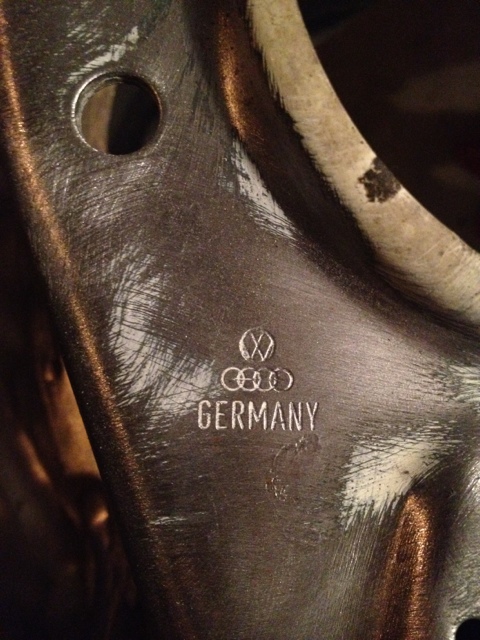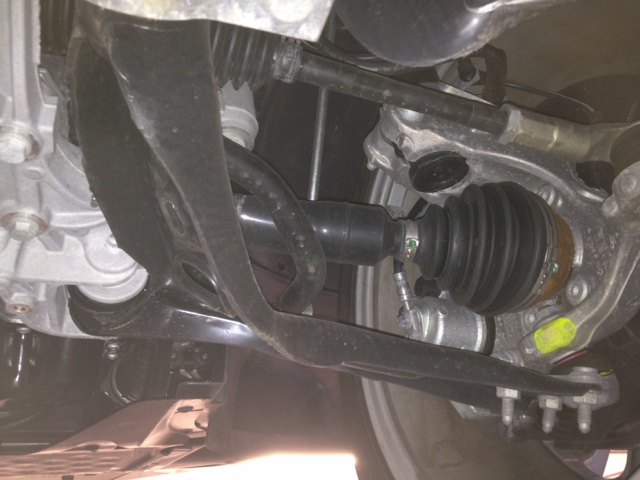Hey everyone! We got some Shop Shots for ya today! Remember that all of these pictures come to you from behind the scenes of a VW dealer. These are some of the things that an auto mechanic will see from day to day. Some good, some scary, some super gross, but all of them are the real deal Okay, let’s go~
Here is a picture of a catalytic converter on a 2007 GTI. The customer had a performance exhaust installed on his car. At some point, he had an aftermarket catalytic converter welded in. That bright shiny elbow is a cheat. It is a way to trick the cars computer into thinking that the cat is functioning properly. It moves the rear oxygen sensor further away from the flow of exhaust. That reduces the amount of air it sees. This will let someone install a high flow cat, or no cat at all, and the MIL will not come on. I think some stuff like this is really cool. I like when people find a work around. Of course I officially don’t support cheating the system.
 This was the very first car I worked on the other morning. The customer was saying that the seat back would not adjust. He very cleverly took some bungee cords and secured a couple of pillows. To be honest, it was a pretty cool setup. I would imagine that it would be super comfortable on a road trip. One thing to consider is that an improperly adjusted seat back can be a safety issue.
This was the very first car I worked on the other morning. The customer was saying that the seat back would not adjust. He very cleverly took some bungee cords and secured a couple of pillows. To be honest, it was a pretty cool setup. I would imagine that it would be super comfortable on a road trip. One thing to consider is that an improperly adjusted seat back can be a safety issue.
If you have ever had a VW, you might have noticed that the seat back adjustment is strange. It has that knob on the side that needs to be turned. I have had lots of folks tell me the knob didn’t work. The trick is to lean forward just a little, and the seat back will move just fine. This setup is suppose to be a safer design than the lever that most cars have.
Oh, this car’s seat worked just fine. I lubed his squeaky door and sent him on his way.
 This is another shot from outside the shop. I was visiting a buddy who is restoring a GTI. We were in his garage having a good craft beer, and chatting about his plans for the car. I looked down and this caught my eye. How cool is it to have a 25+ year old car with that logo on it. AWESOME! Yeah, that was just a little VW nerding out on my part
This is another shot from outside the shop. I was visiting a buddy who is restoring a GTI. We were in his garage having a good craft beer, and chatting about his plans for the car. I looked down and this caught my eye. How cool is it to have a 25+ year old car with that logo on it. AWESOME! Yeah, that was just a little VW nerding out on my part
 This picture goes along with the video below. This is a CC with about 900 miles on it. The customer slide into a curb and restored the wheel and bent the control arm. That piece should be NOT be bent like that. When you watch the video, you will see what it looks like from the outside of the car. The rumor is the guy was wasted when this happened. I have no way of confirming that!
This picture goes along with the video below. This is a CC with about 900 miles on it. The customer slide into a curb and restored the wheel and bent the control arm. That piece should be NOT be bent like that. When you watch the video, you will see what it looks like from the outside of the car. The rumor is the guy was wasted when this happened. I have no way of confirming that!
So, you might have noticed that sweet intro on this video. A good friend of mine built that for me. I can not take any credit for it (I wish I could). This will be on all of the videos going forward. I almost peed my pants when I watched it for the first time. This dude is so damn talented!
Ok, back the video. You can see how close the tire is to the back of the wheel well. The whale noise that you are hearing is the rim scrapping the control arm(the bent part in the pic above). We were really cracking up about the damage.
Well, there you have it, another round of Shop Shots in the books. A quick Cabby update, I drove her home yesterday. She is now safe and sound in my garage. I have to swing by work today and pick up the Passat..
If you think that the intro is totally amazing, mash one of the share buttons! It will help me thank the guy that made it.











